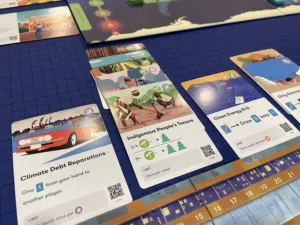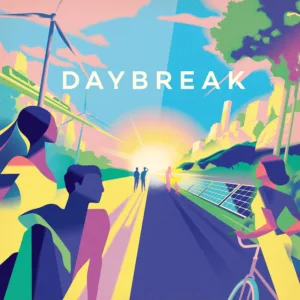 The first “environmental” game this reviewer recalls seeing is Vital Lacerda’s CO2 (2012). While admirable in its laser focus on semi-cooperation and the combination of planning, production and conversion of polluting power infrastructure, it sits proudly at the microeconomic level, engaging players not as specific countries or activists, but as CEOs of energy companies.
The first “environmental” game this reviewer recalls seeing is Vital Lacerda’s CO2 (2012). While admirable in its laser focus on semi-cooperation and the combination of planning, production and conversion of polluting power infrastructure, it sits proudly at the microeconomic level, engaging players not as specific countries or activists, but as CEOs of energy companies.
Now we come to a much-anticipated title from veteran designer Matt Leacock and newcomer Matteo Menapace. Daybreak is a cooperative game with players acting as world governments who have collectively decided to solve the climate crisis from all angles. Over a series of rounds, players will create projects collectively and individually, attempt to side-step crises, and reach the critical goal of carbon drawdown, where more carbon is being removed from the atmosphere than created. It’s a cooperative game for up to 4 players and takes about 1-2 hours to play. For a best first experience, this reviewer recommends playing with 2 players.
Gameplay Overview:
A game of Daybreak proceeds over 6 rounds. In each round, players will take on the following stages:
Global Stage – During this step, players will collectively choose a Global Project card which acts like a bonus ability that any player can use.

Local Stage – This is the heart of player decision-making in the game. Each player begins play with 5 Local Projects and then receives up to 5 cards every round. All players make interactive simultaneous choices about which cards to play (either as new projects or enhancing others), which to use as “currency”, and which they might be able to give to other players depending on their card abilities.
Every Local Project card has a benefit or an ability that can be activated by a player with some positive effect that will either immediately benefit the country’s task of reducing carbon emissions or converting polluting energy sources into carbon neutral sources. Cards may also increase a player’s resilience to withstand the crises the game throws at them or aid them in helping other players.
It’s best for all the players to strategize together about the most effective choices for each individual country, because that usually works out for the group. Since the game eschews any mention of there being a semi-cooperative aspect to global policy, this becomes a, hopefully, friendly discussion about what carbon producing problems to take on and which to abandon. Once players have agreed that they have played or used all the cards they want to use (they don’t have to play all of them), the game moves on.
Emissions Stage – At this step, players count up all their pollution sources and then create a pool of carbon tokens placed, literally, in the upper part of the board which represents the atmosphere. If enough carbon is placed, players increase the temperature scale. This is probably the most important part of the challenge of the game since as the temperature goes up, players will be drawing more Crisis Cards and rolling the Planetary Effects die, which determines which global environmental effects occur. This is a series of tracks representing things such as the loss of Arctic sea ice, desertification of the land, or the dieback of the Amazon rainforest.

Crisis Stage – During this dangerous step, players draw Crisis Cards that increase the difficulty of the game or ruin players’ options during the game. Players can acquire Resilience tokens to avoid or lessen these effects.
Growth Stage – As every player represents a country in the game, this step increases the game’s difficulty every round by increasing the population of countries. Players must provide enough energy, round over round, to meet their energy demand or they run the risk of creating “Communities in Crisis”. This is an abstract representation of the stability of the global population. If people are too desperate for their basic needs, they’re unlikely to support projects to help the players in the game succeed. When a player has too many of these communities, they draw fewer cards during the Local Stage.
The goal of all players is to reach the point where players are not adding emissions that increase the global temperature. Having some carbon emission is fine, as long as there are other projects, trees or oceans to remove it. However, the players must also survive to the end of the game round in which they hit this target before they may declare victory.

Game Experience:
This reviewer is a big fan of the theme. The kind of challenge Daybreak represents goes beyond anything humanity has ever faced (with the possible exception of dealing with the threat of nuclear war). However, it also nudges aside any of the complications that come with that. As a cooperative game, and with the “default” way to play, it doesn’t matter how many “Communities in Crisis” one player has as long as the group wins.

This is a game of course, and it doesn’t need to represent reality. But thankfully, the game includes a series of “Challenge Cards” which increase the difficulty by adding adjustments to the game victory requirements, impeding the players in some way, or just simply making the starting game-state more difficult. These are a warm welcome to the overall production.
The juiciest moments of Daybreak come when players collectively can pull off great, powerful combos with their cards. One card may allow a player to draw extra cards, and they might have another ability to give cards to a second player. That player can then spend cards to increase forests or convert polluting energy into green energy. Each round, this back-and-forth, dynamic test of players feels energetic and exciting as players gain more cards and stronger abilities from enhancing other cards.
One other aspect to the production, immediately noticeable from the game’s contents is that there is no part of the game that is non-recyclable. All the components are made of cardboard or wood. Even the included trays and game organization system work perfectly even though they resemble take-out containers.

However, this game doesn’t abandon all technology. There’s a QR code on every project card that explains how the card works from a game-mechanism point of view and from a thematic point of view. This is a superb level of support by a publisher that should be emulated by all other companies.
The real negative, and this is not something to level at Daybreak individually, is the common problem of alpha-gamer syndrome. Since all the game information held by any individual player is open to all players, there exists a strong possibility for one player to know EXACTLY what every other player should do, as if they are playing a solo game. One recommendation for this is that players may play with hidden information (closed hands) as much as they wish. This could also represent the cautious nature of some societies hiding what they see as privileged information.
Final Thoughts:
Ultimately, Daybreak is a strong, enjoyable offering with lots of options to consider. If you’re a fan of the theme and the cooperative style of play, this game is a must-have. If you’re just coming off enjoying Pandemic, this is a good next level game. If, however, you’re cautious to participate in another cooperative experience having been burned by one before, take a look at games with hidden information or just decide you’re going to play on hard mode for this one. It’s definitely worth it.
Final Score: 4.5 stars – Daybreak hits all the right marks for a game with an environmental theme.
 Hits:
Hits:
• Interesting cooperative tableau building
• Fantastic assistance online for card abilities
• Component quality
• Game-altering Challenge Cards
Misses:
• Alpha-gamer issues common with some cooperative games
• No innovation in play format
Source: Board Game Quest





